Post Type Visualizer
Hover over a post and click to view an image of its hardware and a description of its function.
Cable Railing
Rod Railing
Currently viewing cable railing info.
Common Post Types
"A" Post
Cable Railing
Rod Railing
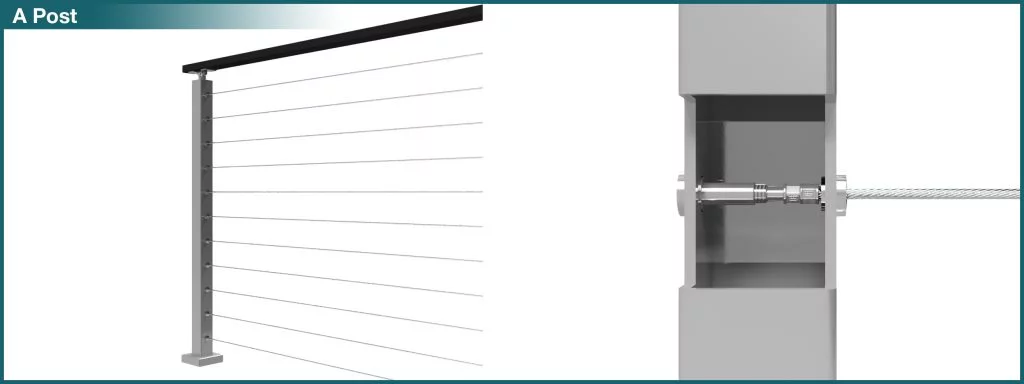
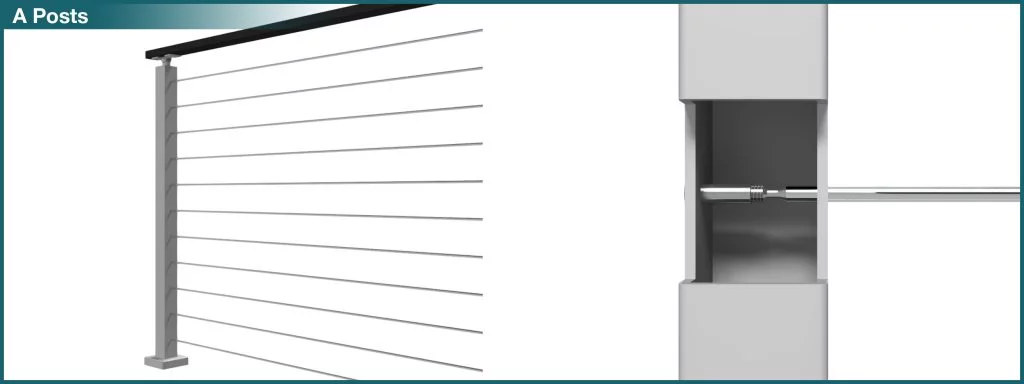
"A" posts are used to begin or end level railing runs with tension kits.
Cable railing "A" posts use "Level Tension Kits" to create tension.
Rod railing "A" posts use "Level Tension Ends" to create tension.
"A-2" Post
Cable Railing
Rod Railing
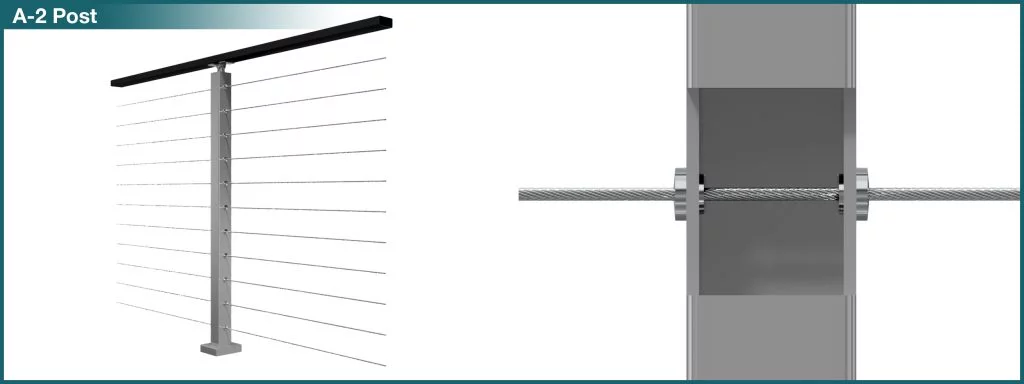
"A-2" posts are used only on level, intermediate cable railing posts.
These are pass-through posts with 1/2" holes on both sides. "Steel Insert Sleeves" are tapped into each hole on site. The sleeves provide a clean look and keep the cable from rubbing against the post.
The rod railing equivalent is an "A-5" post.
"A-5" Post
Cable Railing
Rod Railing
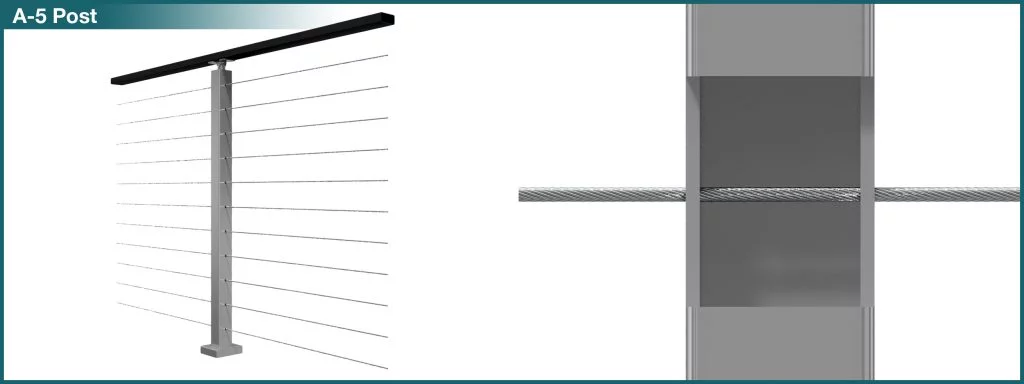
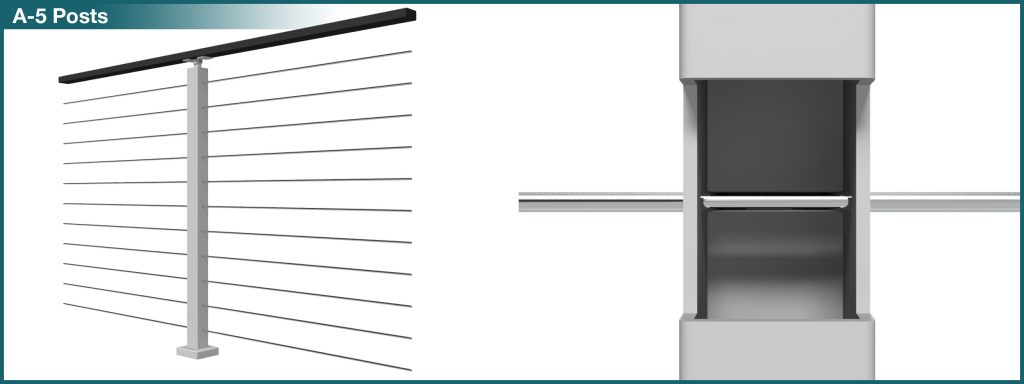
"A-5" posts are level, intermediate posts that do not have any hardware.
Signature cable railing "A-5" posts have 5/16" holes on both sides with a 5/32" cable passing through, leaving a slight gap between the hole and the cable.
Rod railing "A-5" posts have 5/16" holes on both sides with a 1/4" rod passing through. Each rod post comes with foam insert to prevent any rattling or contact between the rod and post.
"B-5" Post
Cable Railing
Rod Railing
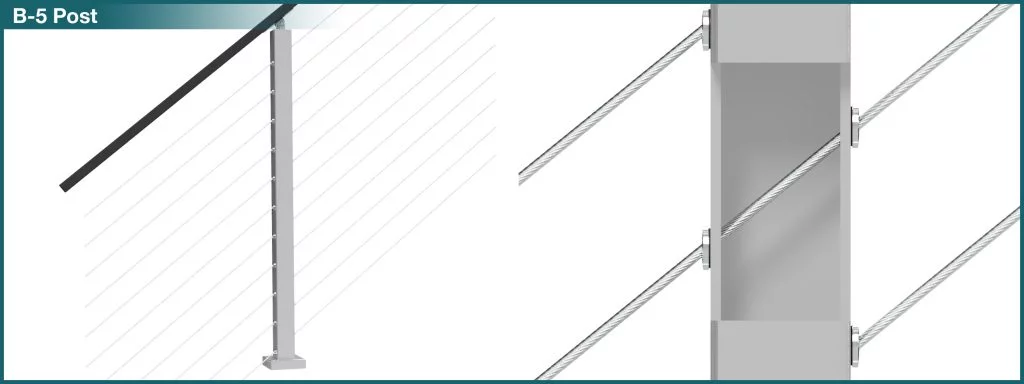
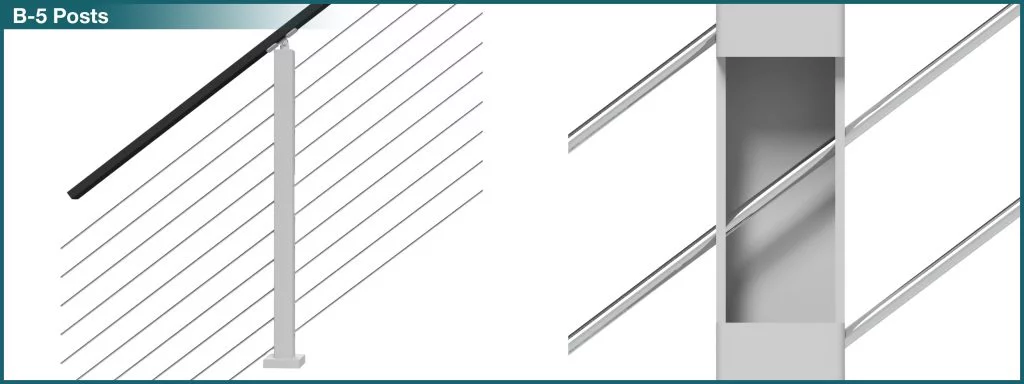
"B-5" posts are angled, intermediate posts.
Signature cable railing "B-5" posts have 5/16" holes on both sides with a 5/32" cable passing through. To prevent the cable from rubbing against the post, cable "B-5" posts use "Steel Adhesive Sleeves" around each 5/16" hole.
Rod railing "B-5" posts have 5/16" holes on both sides with a 1/4" rod passing through at an angle. Each rod post comes with foam insert to prevent any rattling or contact between the rod and post.
"B-UP" Post
Cable Railing
Rod Railing
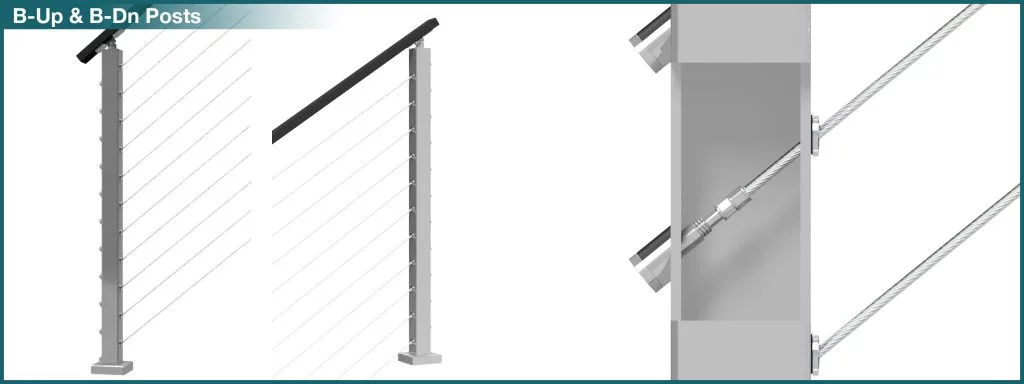
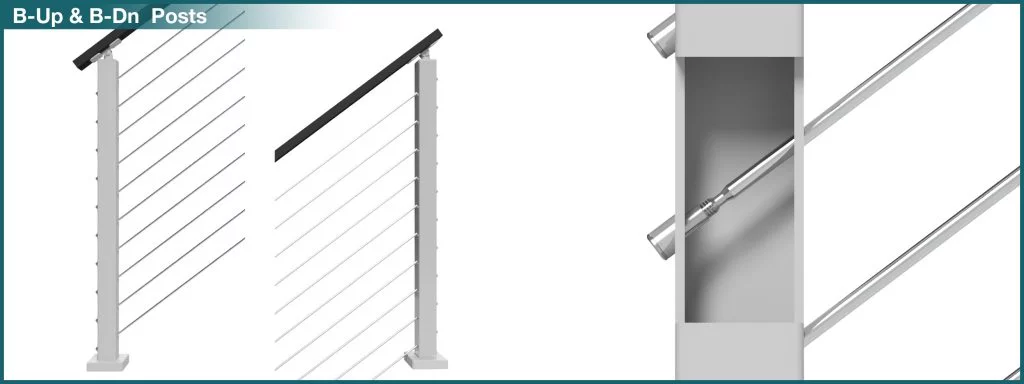
"B-UP" posts are angled end posts that provide tension at the beginning of an angled run.
Cable "B-UP" posts use "Angled Tension Kits" through offset holes. You can identify a "B-UP" post by looking for 1/2" holes on the lower set and 5/16" holes on the higher set.
Rod "B-UP" posts use "Angled Tension Ends" through offset, 5/16" holes on both sides.
"B-DOWN" Post
Cable Railing
Rod Railing


"B-DOWN" posts are angled end posts that provide tension on an angled run.
Cable "B-DOWN" posts use "Angled Tension Kits" through offset holes. You can identify a "B-DOWN" post by looking for 5/16" holes on the lower set and 1/2" holes on the higher set.
Rod "B-DOWN" posts use "Angled Tension Ends" through offset, 5/16" holes on both sides.
"C" Post
Cable Railing
Rod Railing
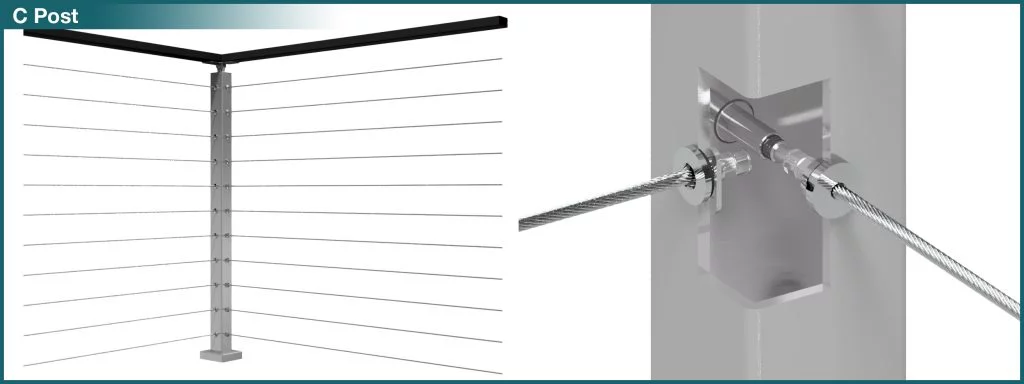
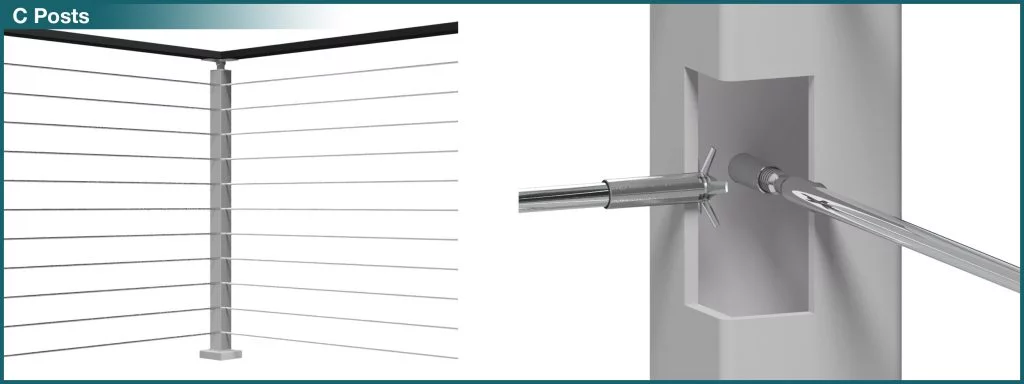
"C" posts are used to join two level railings into one corner post.
Cable "C" posts use an "Inside Post Mount" to end a run, and a "Level Tension Kit" to start a new, perpendicular run on the same plane. The hardware from the two separate runs of cable is hidden inside the post to make it look as if there is only one cable.
Rod "C" posts use a "Level Rod Anchor" to end a run, and "Level Tension End" to start a new, perpendicular run on the same plane. The hardware from the two separate runs of rod is hidden inside the post to make it look as if there is only one rod.
"D" Post
Cable Railing
Rod Railing
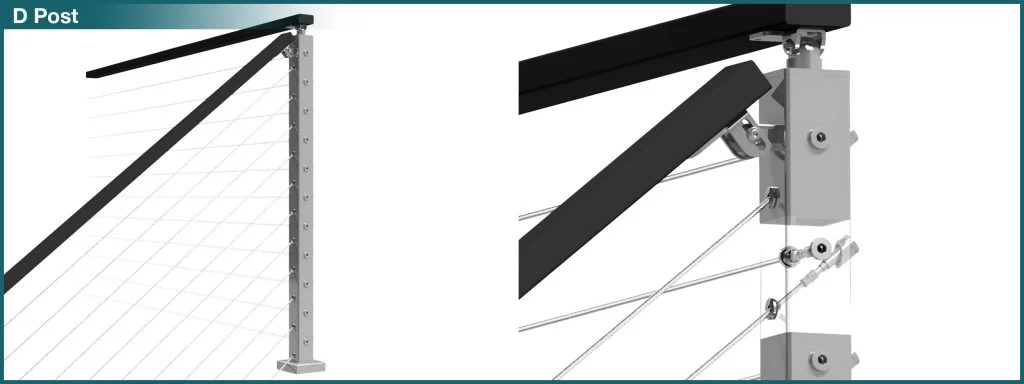
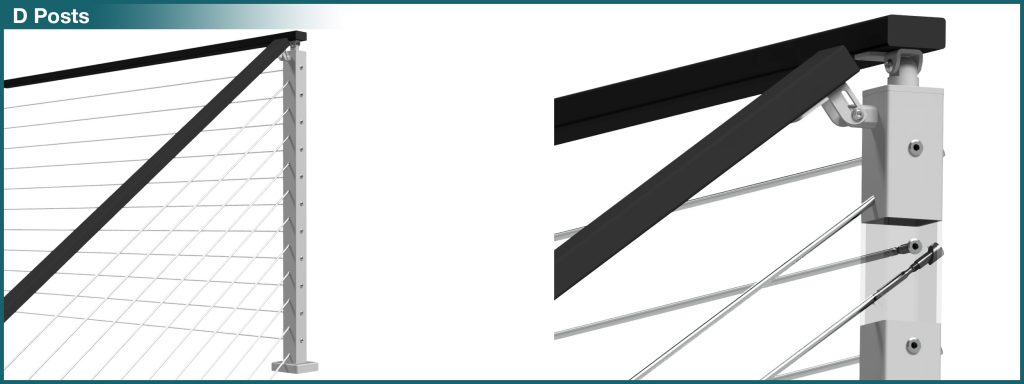
"D" posts are used to join an angled railing with a level railing of the same height into a 90° corner.
Cable "D" posts run an "Angle Tension Kit" and a "Level Tension Kit" through the post to start a new, perpendicular run on the same plane. Although there are two runs of cable in one post, the angled and level hardware do not interfere with each other. Angled holes have a 5/16" hole on the lower set, and 1/2" holes on the upper set. Level holes are 1/2" on each side.
Rod "D" posts run an "Angle Tension End" and a "Level Tension End" through the post to start a new, perpendicular run on the same plane. Although there are two runs of rods in one post, the angled and level hardware do not interfere with each other. Each side will have 5/16" holes running through the post.
"F" Post
Cable Railing
Rod Railing
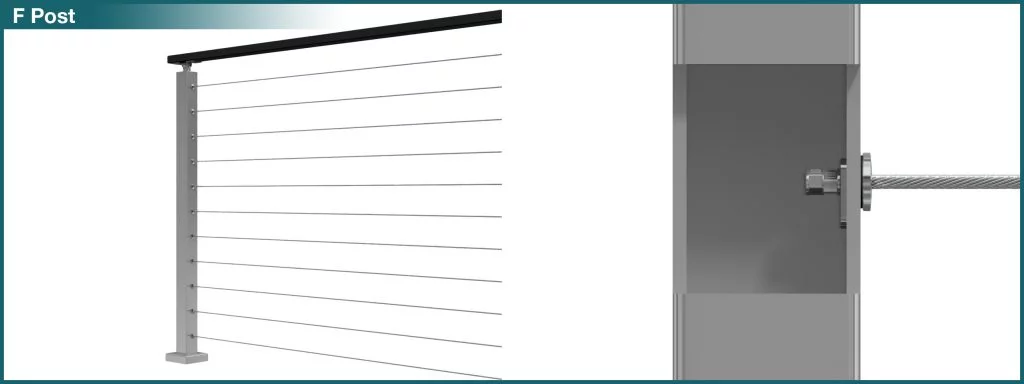
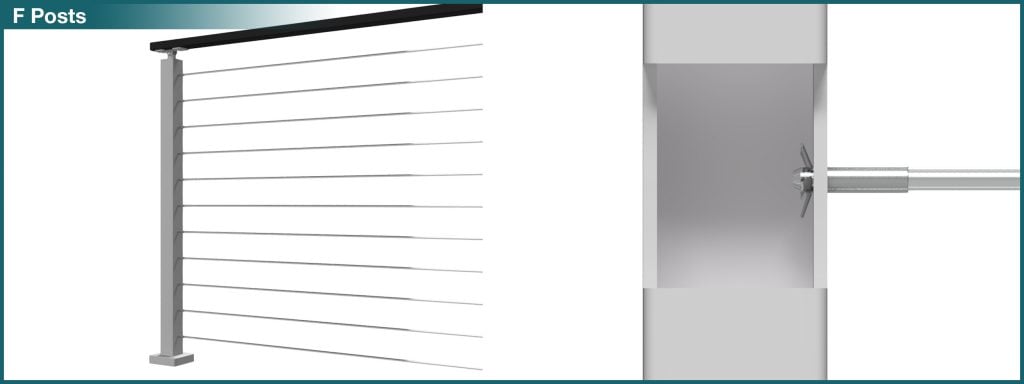
"F" posts are used to end level runs without utilizing a tension kit. They have a 5/16" hole on one side of the post.
Cable "F" posts use an "Inside Post Mount" to lock to the inside of the post. This type of post is used when there is not enough space behind the post to use an Allen wrench. Since this cable hardware does not take tension, the opposite end of the level run will require a "Level Tension Kit."
Rod "F" posts use a "Level Rod Anchor" to lock to the inside of the post. This type of post is used when there is not enough space behind the post to use an Allen wrench. Since this rod hardware does not take tension, the opposite end of the level run will require a "Level Tension End."
"G" Post
Cable Railing
Rod Railing
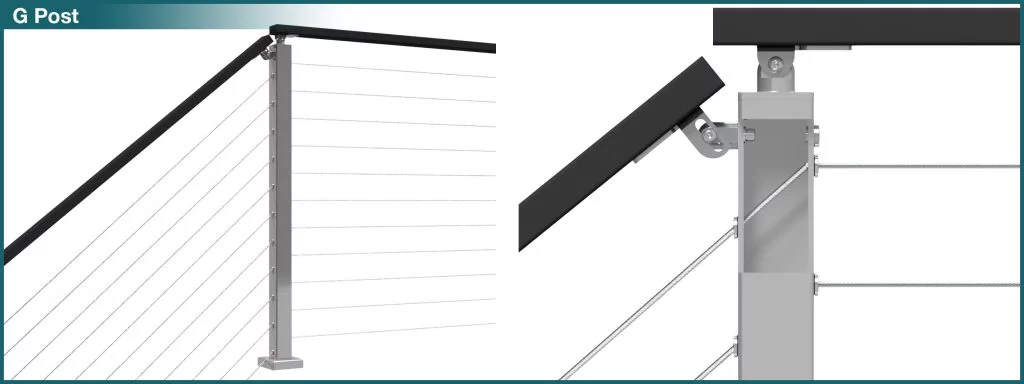
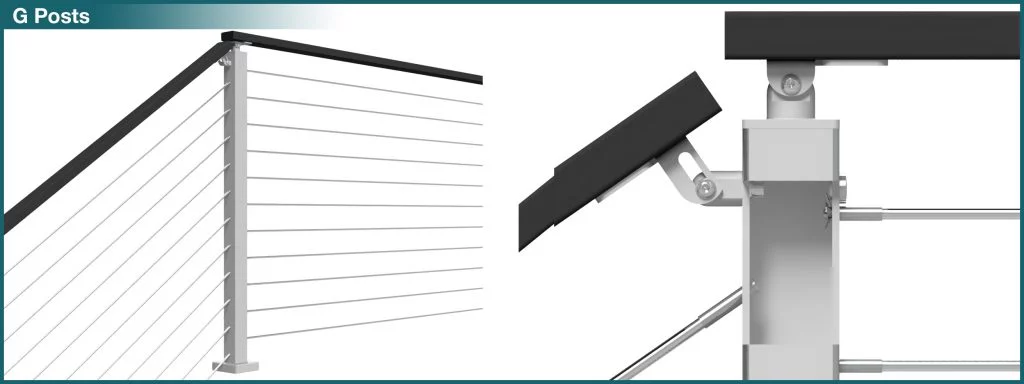
"G" posts are used to transition from an angled run to a level run of the same height without turning.
Cable "G" posts have offset, 5/16" holes through each side of the post for the cable to continuously run through.
Rod "G" posts have offset 5/16" holes on each side of the post. The rods end into an "Angle Rod Anchor" on the stair side of the post, and start with a "Level Rod Anchor" on the level side.
"H" Post
Cable Railing
Rod Railing
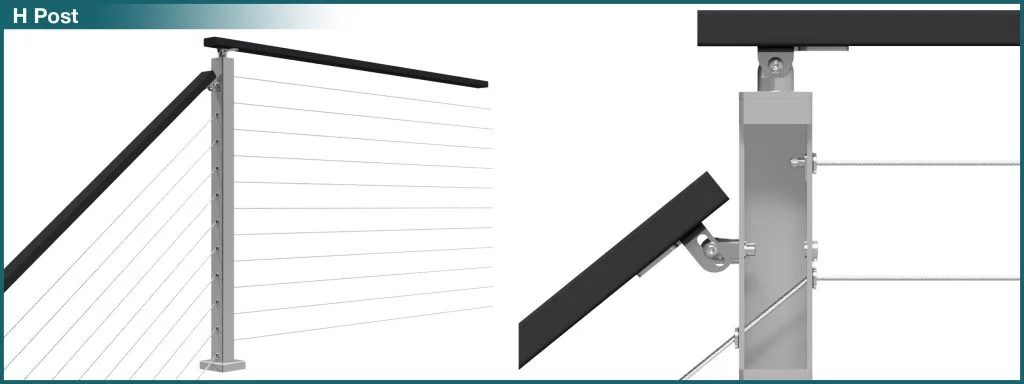
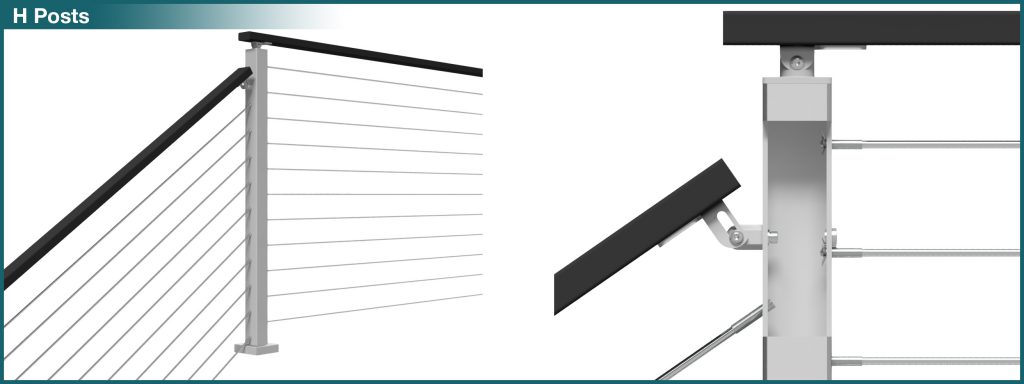
"H" posts are used to transition from an angled run to a taller level run without turning.
Cable "H" posts have offset 5/16" holes through each side of the post for the first 10 runs of cable to run through. Since the level run of cable is taller, an additional run(s) of cable will begin using "Inside Post Mount Kits."
Rod "H" posts have offset 5/16" holes on each side of the post. The rods end into an "Angle Rod Anchor" on the stair side of the post, and start with a "Level Rod Anchor" on the level side of the post.
"I" Post
Cable Railing
Rod Railing
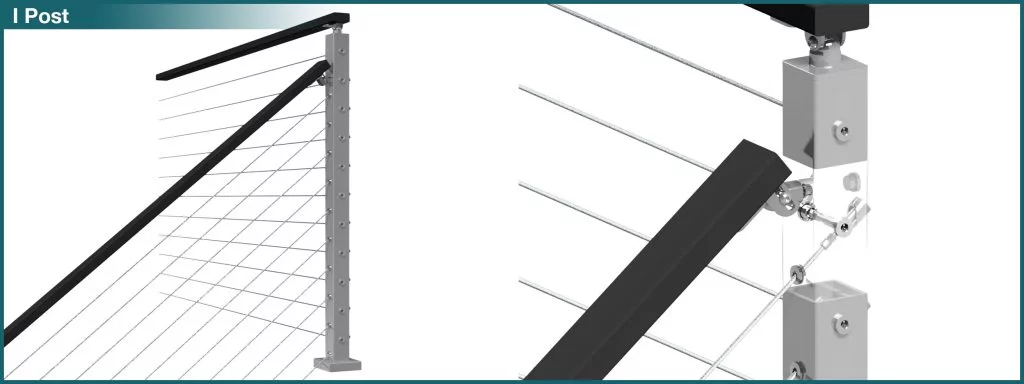
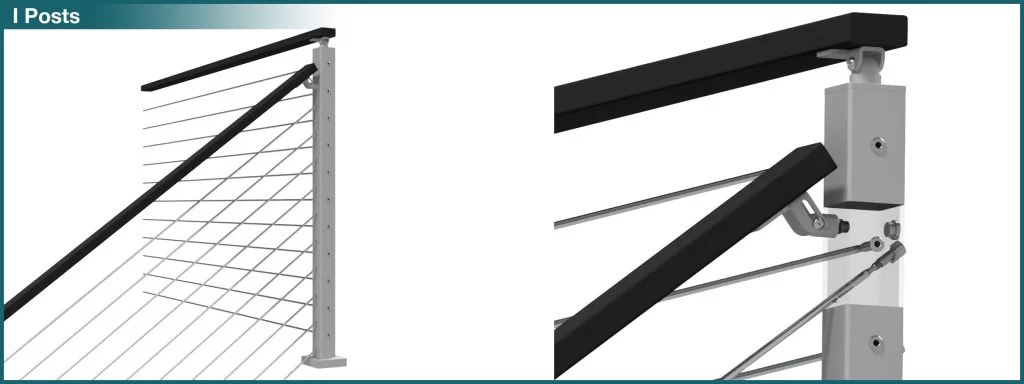
"I" posts are used to join an angled run with a taller level run at a 90° corner.
Cable "I" posts run an "Angle Tension Kit" and a "Level Tension Kit" through the post to start a new, perpendicular run on the same plane. Although there are two runs of cable in one post, the angled and level hardware do not interfere with each other. The angled holes have a 5/16" hole on the lower set of holes and 1/2" holes on the upper set. The level holes are 1/2" on each side.
Rod "I" posts run an "Angle Tension End" and a "Level Tension End" through the post to start a new, perpendicular run on the same plane. Although there are two runs of rods in one post, the angled and level hardware do not interfere with each other. Each side will have 5/16" holes running through the post.
"J Up" Post
Cable Railing
Rod Railing
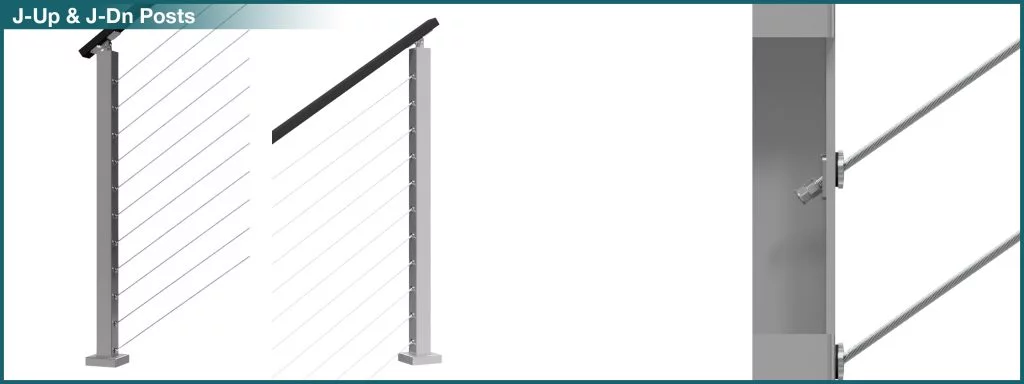
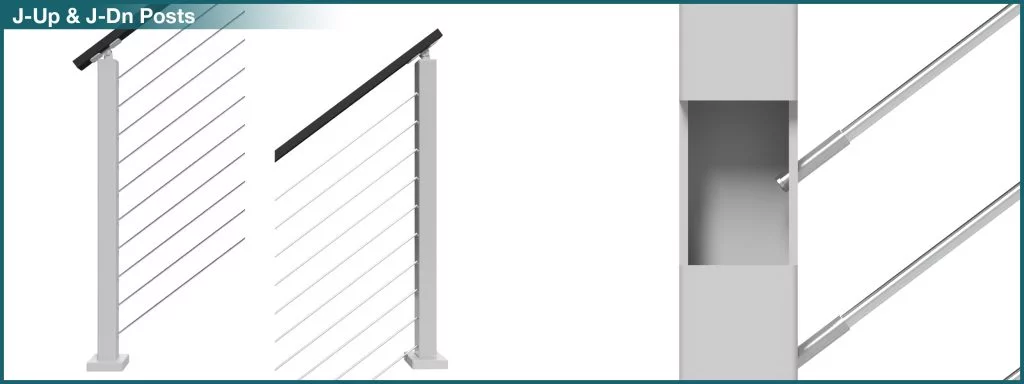
"J-UP" posts are used to start runs at the bottom of the stair without using a tension kit.
Cable "J-UP" posts have 5/16" holes on the stair side of the post and use "Inside Post Mounts." Since there is not tension on this post, an "Angle Tension Kit" is required on the other end of the run. This post type is used to create a finished post face, when desired.
Rod "J-UP" posts have 5/16" holes on the stair side of the post and use "Angle Rod Anchors." Since there is not tension on this post, an "Angle Tension End" is required on the other end of the run. This post type is used to create a finished post face, when desired.
"J Down" Post
Cable Railing
Rod Railing


"J-DOWN" posts are used to end runs at the top of a staircase without using a tension kit.
Cable "J-DOWN" posts have 5/16" holes on the stair side of the post and use "Inside Post Mounts." Since there is not tension on this post, an "Angle Tension Kit" is required on the other end of the run. This post type is used to create a finished post face when desired, or if there is not enough space between the post and a structure to use an Allen wrench.
Rod "J-DOWN" posts have 5/16" holes on the stair side of the post and use "Angle Rod Anchors." Since there is not tension on this post, an "Angle Tension End" is required on the other end of the run. This post type is used to create a finished post face when desired, or if there is not enough space between the post and a structure to use an Allen wrench.
"R" Post
Cable Railing
Rod Railing
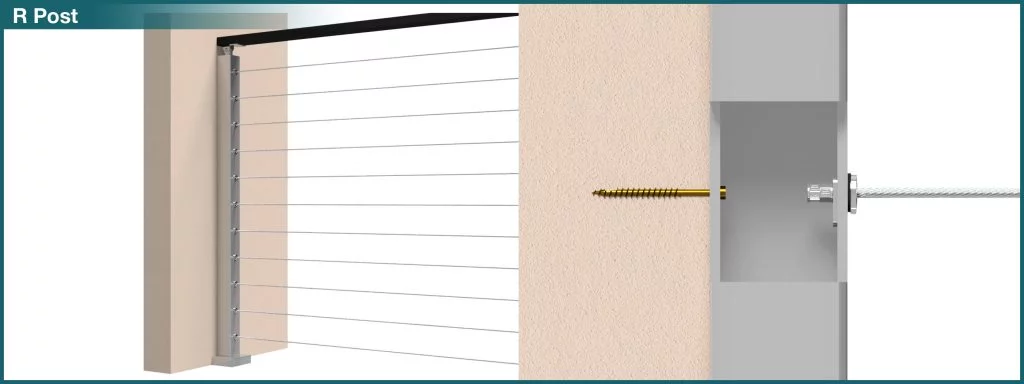
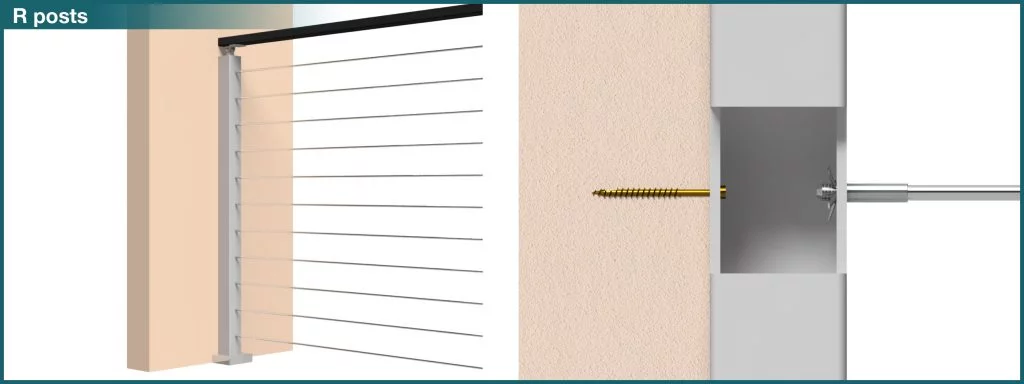
"R" posts have a three-sided foot plate, and mount to a structure on one side. They are used to end level runs without using a tension kit.
Cable "R" posts use an "Inside Post Mount" to lock to the inside of the post. This post is mounted to both a wall or structure, and the floor. Since this cable hardware does not take tension, the opposite end of the level run will require a "Level Tension Kit."
Rod "R" posts use a "Level Rod Anchor" to lock to the inside of the post. This post is mounted to both a wall or structure, and the floor. Since this cable hardware does not take tension, the opposite end of the level run will require a "Level Tension End."
"S" Post
Cable Railing
Rod Railing
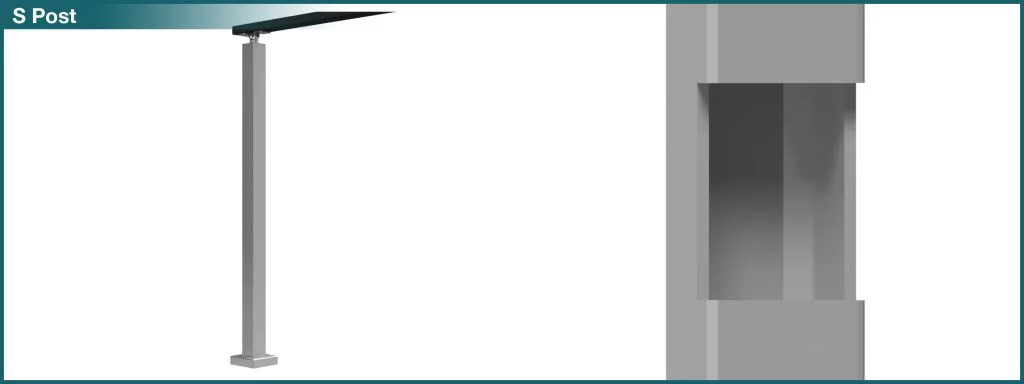

"S" Posts are blank posts most often used as the hinge post of a gate, or just to fill space.